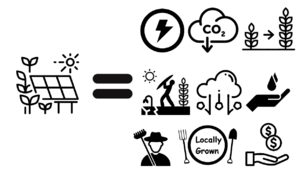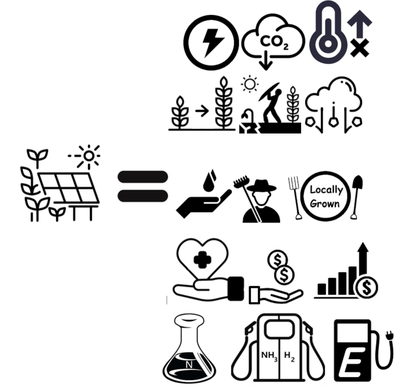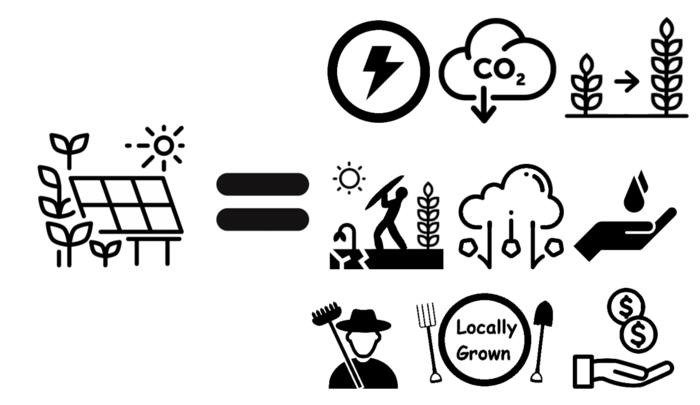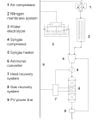
Well-intentioned regulations to protect Canada's most productive farmland restrict large-scale solar photovoltaic (PV) development. The recent innovation of agrivoltaics, which is the co-development of land for both PV and agriculture, makes these regulations obsolete. Burgeoning agrivoltaics research has shown agricultural benefits, including increased yield for a wide range of crops, plant protection from excess solar energy and hail, and improved water conservation, while maintaining agricultural employment and local food supplies. In addition, the renewable electricity generation decreases greenhouse gas emissions while increasing farm revenue. As Canada, and Ontario in particular, is at a strategic disadvantage in agriculture without agrivoltaics, this study investigates the policy changes necessary to capitalize on the benefits of using agrivoltaics in Ontario. Land-use policies in Ontario are reviewed. Then, three case studies (peppers, sweet corn, and winter wheat) are analysed for agrivoltaic potential in Ontario. These results are analysed in conjunction with potential policies that would continue to protect the green-belt of the Golden Horseshoe, while enabling agrivoltaics in Ontario. Four agrivoltaic policy areas are discussed: increased research and development, enhanced education/public awareness, mechanisms to support Canada's farmers converting to agrivoltaics, and using agrivoltaics as a potential source of trade surplus with the U.S.
Services provided by agrivoltaics are denoted by the icons (a) renewable electricity generation, (b) decreased greenhouse gas emissions, (c) increased crop yield, (d) plant protection from excess solar energy, (e) plant protection from inclement weather, such as hail, (f) water conservation, (g) agricultural employment, (h) local food, and (i) increased revenue.
See also[edit | edit source]

- Coal with Carbon Capture and Sequestration is not as Land Use Efficient as Solar Photovoltaic Technology for Climate Neutral Electricity Production
- Dual use of land for PV farms and agriculture literature review
- sheep
- Israeli white plastic reflectors
- A Farmer's Guide to Going Solar (NREL)
- German guidelines: https://www.ise.fraunhofer.de/content/dam/ise/en/documents/publications/studies/APV-Guideline.pdf
- 2021 review
- Miskin, C.K., Li, Y., Perna, A., Ellis, R.G., Grubbs, E.K., Bermel, P. and Agrawal, R., 2019. Sustainable co-production of food and solar power to relax land-use constraints. Nature Sustainability, 2(10), pp.972-980.
- Retrofitting solar parks for agrivoltaics
- Shading PV
- Alexis' talk at American Solar Grazing Association2021
In the News[edit source]
- Agrivoltaics: solar energy + better crops Climate and Nature
- Why solar power and farmers’ fields could be the perfect combination TVO
- Solar farms and sheep show the makings of a clean energy classic duo Business Renewables
- Agrivoltaics charge up St. Albert-area farms St Albert Gazette
- Sheep, solar and crops. How some Alberta farms are creating ideal growing conditions Western Wheel
- Sheep, solar and crops. How some Alberta farms create ideal growing conditions Voxpopuli
- Protein bars from recycled plastic bottles? An indoor farm on wheels? Western prof gets innovative with green tech Toronto Star
- 加拿大环保狂人回收塑料瓶制成蛋白棒 还有可移动室内农场!? Lahoo
- Solar
- Papers
- Agrivoltaics
- Solar power
- Solar energy
- Photovoltaics
- Sustainable development
- Agriculture
- SDG02 Zero hunger
- SDG07 Affordable and clean energy
- SDG08 Decent work and economic growth
- SDG09 Industry innovation and infrastructure
- SDG12 Responsible consumption and production
- Energy
- Land use
- Farming
- Ontario
- FAST Completed





































